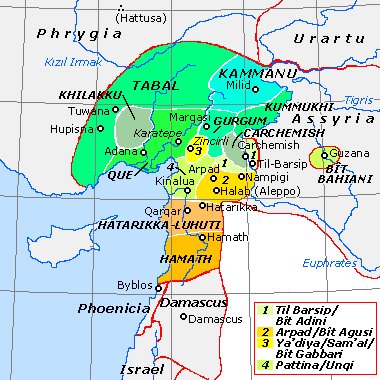Arpad, Syria
 Shown within Syria | |
| Location | Syria |
|---|---|
| Region | Aleppo Governorate |
| Coordinates | 36°28′N 37°06′E / 36.47°N 37.10°E |
Arpad (probably modern Tell Rifaat, Syria) was an ancient Aramaean Syro-Hittite city located in north-western Syria, north of Aleppo. It became the capital of the Aramaean state of Bit Agusi established by Gusi of Yakhan in the 9th century BC.[1] Bit Agusi stretched from the A'zaz area in the north to Hamath in the south.[2]
Arpad later became a major vassal city of the Kingdom of Urartu. In 743 BC, during the Urartu-Assyria War, the Neo-Assyrian king Tiglath-Pileser III laid siege to Arpad following the defeat of the Urartuan army of Sarduri II at Samsat. But the city of Arpad did not surrender easily. It took Tiglath-Pileser three years of siege to conquer Arpad, whereupon he massacred its inhabitants and destroyed the city.[3] Afterward Arpad served as a provincial capital.[4] Tell Rifaat, which is probably the remains of Arpad, has walls still preserved to a height of eight meters.[5]
Biblical references
The city is mentioned in the Hebrew Bible several times:
The Assyrian vizier, Rabshakeh, lists the god(s) of Arpad among those who he alleges have been unable to save their cities from Assyrian assault.[6]
Etymology
The word Arpad in Hebrew means 'the light of redemption',[7] or 'I shall be spread out (or: supported)'[8]
Archaeology
Tel Rifaat is an oval 250 by 233 meters. Within this, the main citadel is 142 by 142 meters with a maximum height of 30 meters. The defensive wall surrounding the site is about two miles long.
The site has been worked by a team from the Institute of Archaeology or the University of London. After a preliminary examination in 1956, Tell Rifa'at was excavated for two seasons in 1961 and 1964. The team was led by M. V. Seton Williams.[9][10]
In 1977, an archaeological survey was conducted of the area around Tell Rifa'at, also by the Institute of Archaeology.[11]
See also
Notes
- ↑ Lipinsky, Edward (2000). The Aramaeans: Their Ancient History, Culture, Religion (Peeters) p. 195.
- ↑ Lipinsky, 2000, p. 99.
- ↑ Healy, Mark (1992). The Ancient Assyrians (Osprey) p. 25.
- ↑ Kipfer, Barbara Ann (2000). Encyclopedic Dictionary of Archaeology. p. 626.
- ↑ Lipinsky, 2000, p. 529.
- ↑ 2 Kings 18:34
- ↑ "Arpad Definition and Meaning - Bible Dictionary". Bible Study Tools.
- ↑ "NETBible: Arpad". classic.net.bible.org.
- ↑ M. V. Seton Williams, Preliminary Report on the Excavations at Tell Rifa'at, Iraq, vol. 23, no. 1, pp. 68-87, 1961
- ↑ M. V. Seton Williams, The Excavations at Tell Rifa'at: 1964 Preliminary Report on, Iraq, vol. 29, no. 1, pp. 16-33, 1967
- ↑ John Matthers, Tell Rifa'at 1977: Preliminary Report of an Archaeological Survey, Iraq, vol. 40, no. 2, pp. 119-162, 1978
References
- P. A. Clayton, The Coins from Tell Rifa'at, Iraq, vol. 29, pp. 143–154, 1967
- Alan R. Millard, Adad-Nirari III, Aram, and Arpad, Palestine Exploration Quarterly, vol. 105, pp. 161–164, 1973
